Below, we look at six patterns of play you can use in the 3-4-3 formation and similar formations such as; 3-4-1-2, 3-4-2-1 and 3-5-2.
Four patterns of play are for wide penetration, while the other two are for central penetration.
If you are coaching the 3-4-3 system or you are participating in any high-level coaching courses such as the UEFA A or B licence where patterns of play are a requirement you may find the below valuable.
While developing this series of passing and moving patterns, I share what has worked for me on the training ground as well as taking influence from some of Europe’s finest teams who operate in this formation.
Among some of the most effective in attack this season is Gian Piero Gasperini’s Atalanta.
They are a hot topic for tactical analysis writers this season, and it is no wonder why.
The Serie A side have owned the 3-4-1-2 formation while boasting the highest xG in Europe and looking a dark horse in latter stages of this years UEFA Champions League.
Below we will look at:
- Why coach patterns of play
- 3-4-3 and its variations
- Central patterns
- Wide patterns
- Getting success
Why coach patterns of play
The bottom line is that we train patterns of play to help players identify and execute pre-determined passing and moving combinations to beat the opponent’s defence.
Sometimes, that may mean penetration to score a goal and other times, it may also mean playing through the opponents’ forwards or midfield to get through their defensive block or pressure.
If you are a coach, also consider individual and team confidence.
When the attacking team only plays in reaction to one another, this means they are trying to discover moments and gaps out of pure randomness to achieve success.
At the same time, the opponent can anticipate and defend.
The likely outcome is a lot of technical and tactical errors that subsequently result in higher turnovers, which can lower a player’s confidence.
On the other hand, when you have a team that knows the system and can execute plays on minimal touches and at such a high speed, the opponent cannot always react to this, which in turn offers a higher chance of success.
3-4-3 Formation and the variations
Just hearing a team play a 3-4-3 formation or a 3-5-2 formation does not tell us the full story of how each player or unit operates in that system in and out of possession.
The 3-4-3 is married closely with the 3-4-1-2, 3-4-2-1 and the 3-5-2.
Depending on the staggered positioning of players at times, it is easy to misinterpret a team’s formation for another.
Generally, a team that plays in a 3-4-3 will usually drop one or two players from its frontline into midfield during the build-up phase.
In the case of learning and adopting patterns of play, I would not over-sensitise the perceived differences.
Considering that all of the patterns of play below can be applied to all variations of the 3-4-3 with minimal tweaking, approach the patterns below with an open mind and consider how slight changes can work for your style of play.
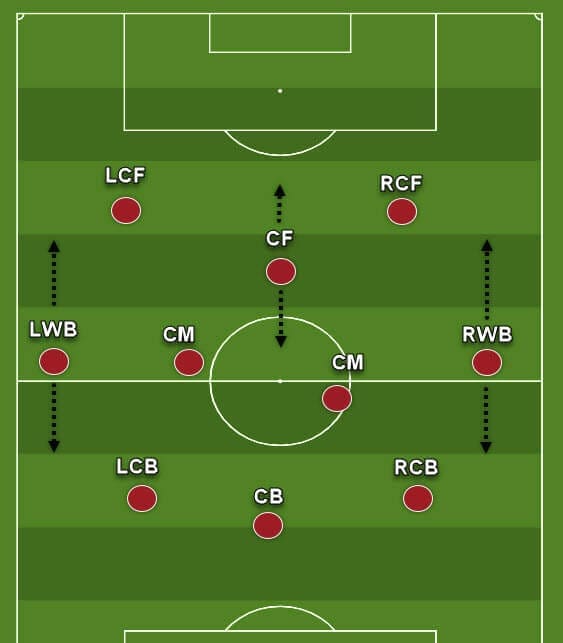
Above, the tactical annotation represents each player’s position in the 3-4-3 formation.
Note how the ‘CF’ can easily be perceived as an attacking midfielder for average in-between distance from the midfield and the forwards.
In the patterns of play below players starting positions honour that of the tactical setup above.
Again, if your team plays a slightly different formation, the same success can still be achieved with minor adjustments if necessary.
Wide patterns
All patterns can be mirrored on both sides of the field.
The ‘blue’ icons on the field represent mannequins.
Work at your own pace, as you may want to gradually introduce one, two, or three defenders along with the mannequins over time.
All patterns of play are set up to play against a back four as represented by the positioning of the mannequins on the field.
For each pattern of play, I recommend positioning the mannequins in natural defensive positions relative to the play.
Wide A
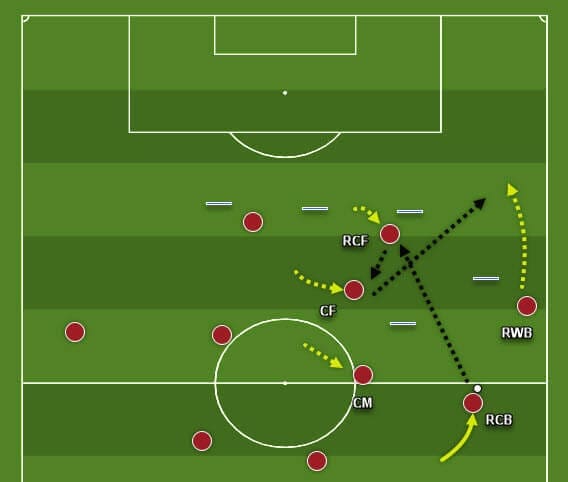
- Play starts with the RCB taking a touch forward to engage the opposition press
- At that time two movements need to happen, the CF makes an angled run into the space offered by the dropping CM
- The RCF makes a short run deep to receive a pass unmarked, at which point he lays off a pass preferably one touch to the CF
- At the same time of the second pass, the RWB makes a well-timed run into the space that would be made available by the pressing full back of the opposition.
- If the CF can play the third pass with one-touch, he should, provided he matches the run of the RWB.
- The RCB should remain a passing option in the game if the final pass forward cannot be executed.
Wide B
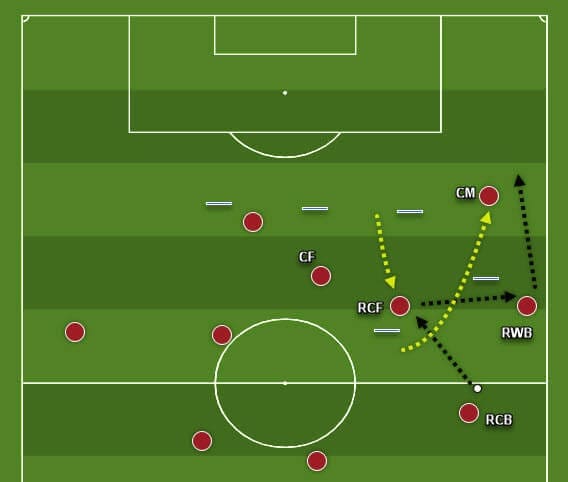
- Play starts with the RCB taking one touch forward, that then is the trigger for the CM to spin and make a run into the space behind the opposition full-back who will be occupying the RWB
- At that time the RCF drops in the vacated central space and receives a pass from the RCB
- With one touch the RCF should look to play a slightly forward pass to the RWB who at that time should move to hold the width
- The third and final pass has to match perfectly with the timing of the run of the CM
- If the RWB should look to play a one-touch pass as a second touch could result on the pass being blocked by a defender in a game
- The RWB should look to play the pass moments before the CM crosses the offside line
- Passing qualities, well times runs and body shape are key to getting success here.
Wide C
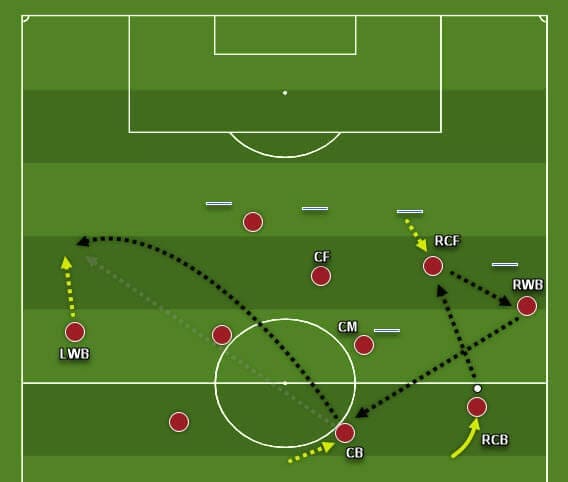
- As the RCB takes a touch forward, this is the trigger for the RCF to drop and receive a pass unmarked
- The RWB should hold his width and have an open body shape to receive a pass from the RCF
- The RWB then looks to play a firm ground pass back to the CB who also should have an open body shape and a sufficient distance from the nearest opponent
- Depending if the CB is right or left-footed he should look to receive and then play a long-lofted pass forward to the oppositions weak side with minimal touches to meet the run of the LWB.
- Depending on relative pressure from the opponent the long pass to switch the play may come from either CM or the CF if the opportunity is available
Wide D
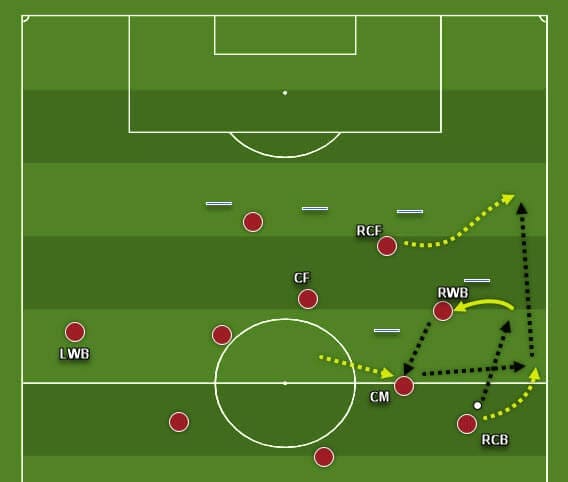
- A four-pass combination that requires good passing qualities, a positive body shape and well-timed runs to get success
- The RCB plays a pass forward to the RWB who should take no more than two touches before passing back to the deeper-lying CM
- At which point the RCB should gradually move forward to join the attack and offer width to make the final pass down the channel.
- As the CM receives a pass from the RWB, he should look to play a slightly forward pass to the RCB on one-touch if possible.
- At which point, as the ball is travelling from the CM to the RCB, the RCF makes an angled run into the channel to meet the attacking pass as well as beating the offside trap
- The RCB should also look to play the fourth and final pass on one-touch as by taking a second or third touch in a game may mean losing the angle for a pass.
- Once the RCF receives a pass in the channel, he should look to get his body around to face forward and see his options attacking the box as the LCF and supporting players offer runs
Central patterns in 3-4-3 Formation
The primary difference between central and wide penetration is that central patterns in the opponent’s half generally result in players arriving in good goal-scoring positions.
Wide patterns that come to fruition typically result in wide crossing positions or dribbling opportunities into the box from a wide position.
That is unless the pattern includes the final ball in the box.
Note that all patterns of play can be mirrored on both sides of the field.
Central A
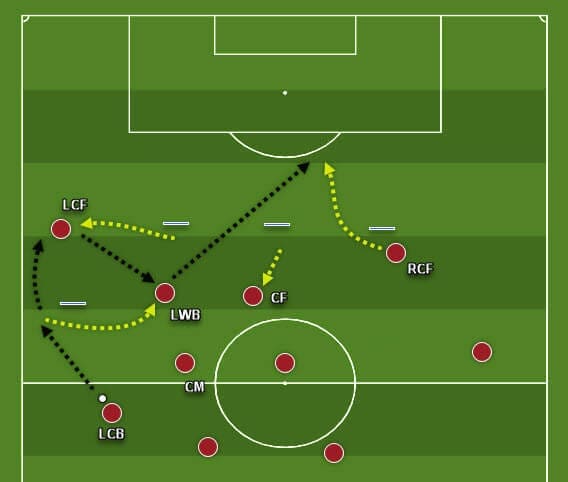
- The LCB plays a firm pass to the LWB; the LWB should have an open body shape to play a forward pass in the channel on his second touch
- The LWB may need to make a sharp ‘away to return’ movement to create space for the second pass
- As the ball is travelling in the first pass, the LCF makes a run into the channel at pace
- As the LWB plays a forward pass to the safe side of the LCF the LWB makes a well-timed run diagonally inside forward into the half-space.
- From that movement, the LCF should look to play a perfectly weighted ground pass into the run of the of LWB
- As the ball is travelling to the LWB two key movement have to happen at this point; the CF must move off his defender to receive a pass to feet, while that happens that’s when the RCF makes an angled run through the gap between the opposition CB and LB (mannequins)
- The fourth and final pass has to match perfectly with the run of the RCF as he beats the offside trap on the blindside of the CB to meet the penetrating pass.
- The passing qualities, body shape, and where the passes are played to teammates are key to success in this pattern.
Central B
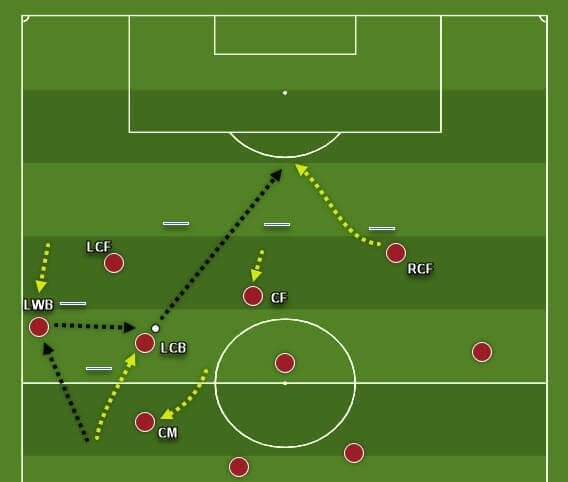
- As the LCB plays the first pass forward to the LWB, he continues his run forward into the half-space. At the same time, the CM drops into the space the LCB came from.
- The CM’s movement is key for two reasons, first, he creates space for the LCB to arrive unmarked on his run. Secondly, should the second pass be denied then the CM has offered an outlet to receive a pass back from the LWB.
- The speed of play gets quite fast from the second pass; however, this is necessary to get success in penetrating the defence.
- Before the second pass is played into the run of the LCB, the CF must make a high to low movement to offer both an angle for the third pass as well as providing a passing option should the chance to penetrate is not on.
- As the LCB receives a pass, the RCF should start his arced run to meet the penetrating pass from the LCB.
- The RCF must time his run well such that he makes a run into the gap between the LB and CB (mannequins) and beats the offside trap with perfect timing to the penetrating pass being played by the LCB.
Getting success
The biggest challenge is getting players to identify the trained pattern of play simultaneously in a 90-minute match.
However, with the right conditions of open play in training, we can develop each players capacity to read the game and identify those moments.
Take a look at my recent coaching articles: ‘Coaching: Patterns of play in 4-4-2′ as well as ‘Coaching: Patterns of play in 4-3-3‘ to see how I coach my players to identify and execute those practised patterns of play in a competitive game.
Options central and wide: We have outlined a total of six options for a team who plays either a 3-4-3 or a variation of that formation to seek out, create and execute.
Passing qualities, as well as the right timing and movement, will always be crucial essentials to get success.
In the beginning, when working with your players, narrow it down to one or a maximum of two patterns per week.
Let them get used to this, learn the pattern well and build confidence.
What-If’s: *This is usually where a coach has to show his value as a mentor, as there will be plenty opportunity for stoppages in the conditioned game, helping the players discover their what-ifs will be crucial for developing a confident possession-based team. Remember it is essential for players to identify not only their patterns of play but also know their what-ifs if the desired outcome cannot be reached.
Mindset, repetition and patience: Try not to hurry success too early, the more you handover performance ownership to the player and create the correct mindset within the group the sooner you will see the rewards of this training.
Facilitating a mindset of discovery and problem solving over error avoidance and forcing opportunities will significantly improve the players learning as well to help create the desired outcome.
If you enjoyed and found this article valuable, or you still have some questions or want to discover more on patterns of play in the 3-4-3 formation, write to me on Twitter @easytactics.
I will follow up with another coaching piece soon on ‘Attacking with inverted wingers’ only here on totalfootballanalysis.com.

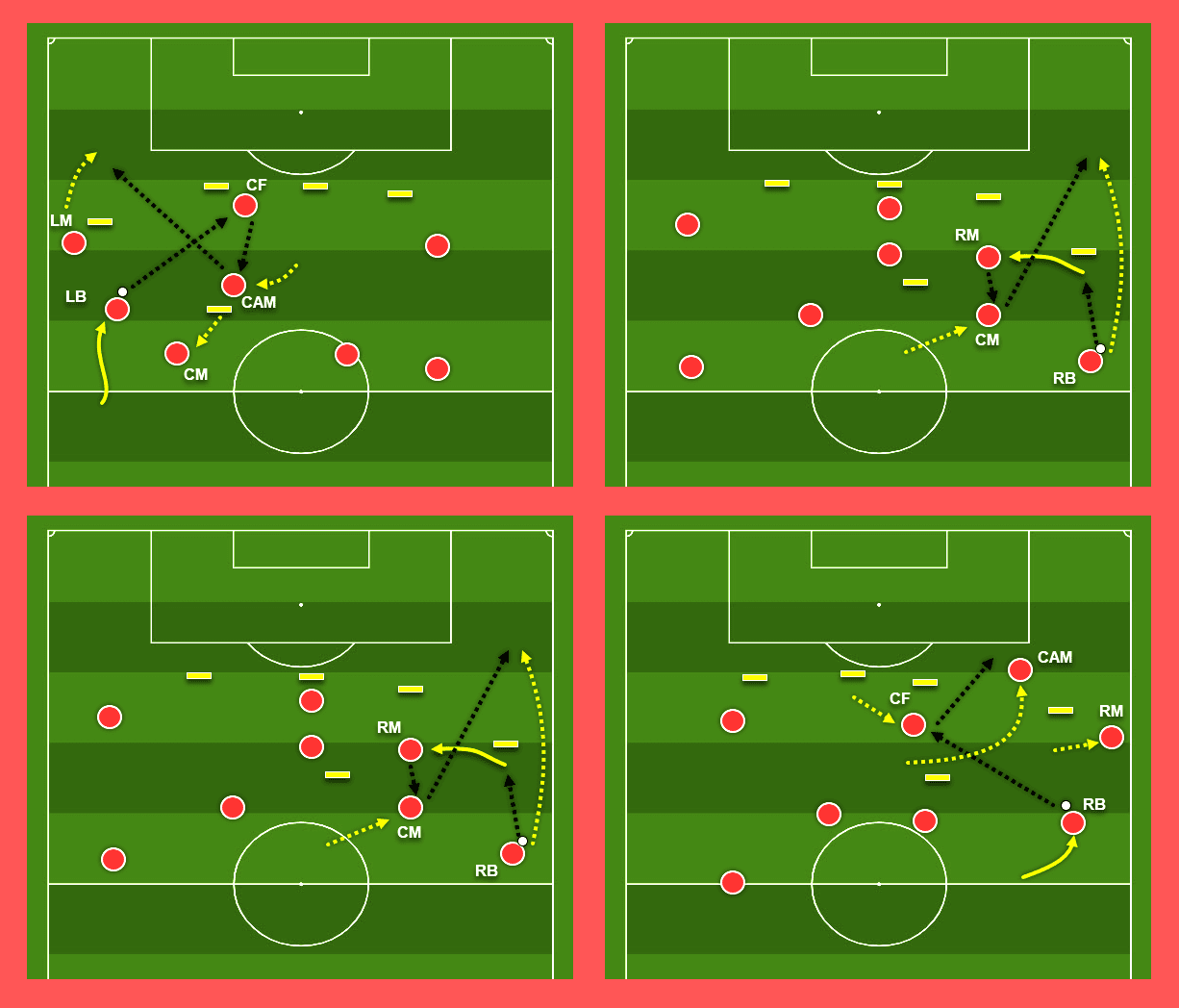



Comments